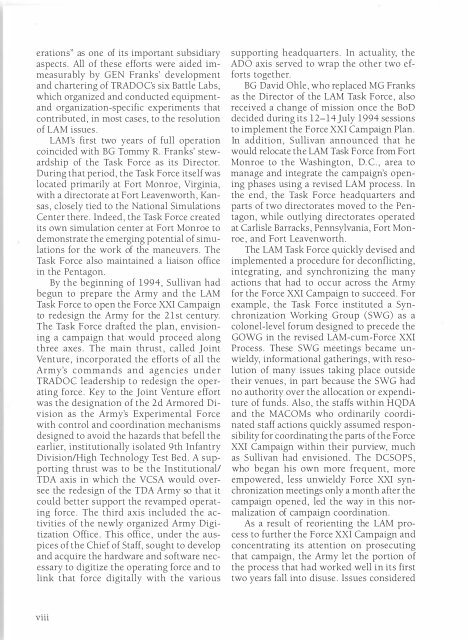The Modern Louisiana Maneuvers - US Army Center Of Military History
The Modern Louisiana Maneuvers - US Army Center Of Military History
The Modern Louisiana Maneuvers - US Army Center Of Military History
Create successful ePaper yourself
Turn your PDF publications into a flip-book with our unique Google optimized e-Paper software.
erations" as one of its important subsidiary<br />
aspects. All of these efforts were aided immeasurably<br />
by GEN Franks' development<br />
and chartering of TRADOCs six Battle Labs,<br />
which organized and conducted equipmentand<br />
organization-specific experiments that<br />
contributed, in most cases, to the resolution<br />
of LAM issues.<br />
LAM's first two years of full operation<br />
coincided with BG Tommy R. Franks' stewardship<br />
of the Task Force as its Director.<br />
During that period, the Task Force itself was<br />
located primarily at Fort Monroe, Virginia,<br />
with a directorate at Fort Leavenworth, Kansas,<br />
closely tied to the National Simulations<br />
<strong>Center</strong> there. Indeed, the Task Force created<br />
its own simulation center at Fort Monroe to<br />
demonstrate the emerging potential of simulations<br />
for the work of the maneuvers. <strong>The</strong><br />
Task Force also maintained a liaison office<br />
in the Pentagon.<br />
By the beginning of 1994, Sullivan had<br />
begun to prepare the <strong>Army</strong> and the LAM<br />
Task Force to open the Force XXI Campaign<br />
to redesign the <strong>Army</strong> for the 21st century.<br />
<strong>The</strong> Task Force drafted the plan, envisioning<br />
a campaign that would proceed along<br />
three axes. <strong>The</strong> main thrust, called Joint<br />
Venture, incorporated the efforts of all the<br />
<strong>Army</strong>'s commands and agencies under<br />
TRADOC leadership to redesign the operating<br />
force. Key to the Joint Venture effort<br />
was the designation of the 2d Armored Division<br />
as the <strong>Army</strong>'s Experimental Force<br />
with control and coordination mechanisms<br />
deSigned to avoid the hazards that befell the<br />
earlier, institutionally isolated 9th Infantry<br />
Division/High Technology Test Bed. A supporting<br />
thrust was to be the Institutional!<br />
TDA axis in which the VCSA would oversee<br />
the redesign of the TDA <strong>Army</strong> so that it<br />
could better support the revamped operating<br />
force. <strong>The</strong> third axis included the activities<br />
of the newly organized <strong>Army</strong> Digitization<br />
<strong>Of</strong>fice. This office, under the auspices<br />
of the Chief of Staff, sought to develop<br />
and acquire the hardware and software necessary<br />
to digitize the operating force and to<br />
link that force digitally with the various<br />
viii<br />
supporting headquarters. In actuality, the<br />
ADO axis served to wrap the other two efforts<br />
together.<br />
BG David Ohle, who replaced MG Franks<br />
as the Director of the LAM Task Force, also<br />
received a change of mission once the BoD<br />
decided during its 12-14 July 1994 sessions<br />
to implement the Force XXI Campaign Plan.<br />
In addition, Sullivan announced that he<br />
would relocate the LAM Task Force from Fort<br />
Monroe to the Washington, D. c., area to<br />
manage and integrate the campaign's opening<br />
phases using a revised LAM process. In<br />
the end, the Task Force headquarters and<br />
parts of two directorates moved to the Pentagon,<br />
while outlying directorates operated<br />
at Carlisle Barracks, Pennsylvania, Fort Monroe,<br />
and Fort Leavenworth.<br />
<strong>The</strong> LAM Task Force qUickly devised and<br />
implemented a procedure for deconflicting,<br />
integrating, and synchronizing the many<br />
actions that had to occur across the <strong>Army</strong><br />
for the Force XXI Campaign to succeed. For<br />
example, the Task Force instituted a Synchronization<br />
Working Group (SWG) as a<br />
colonel-level forum deSigned to precede the<br />
GOWG in the revised LAM-cum-Force XXI<br />
Process. <strong>The</strong>se SWG meetings became unwieldy,<br />
informational gatherings, with resolution<br />
of many issues taking place outside<br />
their venues, in part because the SWG had<br />
no authority over the allocation or expenditure<br />
of funds. Also, the staffs within HQDA<br />
and the MACOMs who ordinarily coordinated<br />
staff actions qUickly assumed responsibility<br />
for coordinating the parts of the Force<br />
XXI Campaign within their purview, much<br />
as Sullivan had envisioned. <strong>The</strong> DCSOPS,<br />
who began his own more frequent, more<br />
empowered, less unwieldy Force XXI synchronization<br />
meetings only a month after the<br />
campaign opened, led the way in this normalization<br />
of campaign coordination.<br />
As a result of reorienting the LAM process<br />
to further the Force XXI Campaign and<br />
concentrating its attention on prosecuting<br />
that campaign, the <strong>Army</strong> let the portion of<br />
the process that had worked well in its first<br />
two years fall into disuse. Issues considered
















